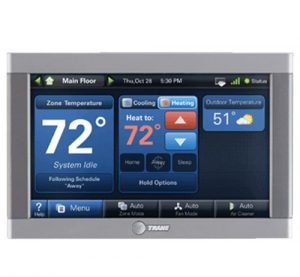If you’re a homeowner who has a heat pump, then you may be wondering what those little heat strips on the back of your unit are for.
Heat strips are essentially an extra heating element that can be used to supplement your heat pump when outdoor temperatures get really cold.
In this article, we’ll explain exactly what heat strips are and how they work. We’ll also discuss when it’s recommended to use them.
If you’re curious about heat strips for heat pumps, keep reading!
What Are Electric Heat Strips for Heat Pumps?
Almost all heat pump systems come equipped with a heat strip, which is a coil-like element that generates heat when electricity flows through it.
These strips are designed with more traditional technology and are usually used as a supplemental or secondary heat source.
When the outdoor temperature gets really low, your system fan can blow air across the strips to distribute that heat into your house.
Heat strips are an essential component of any heat pump system. Thus, homeowners need to be familiar with them.
How Do Electric Heat Strips Work?
Most homeowners have probably encountered heat strips at least once in their life. However, have you ever stopped to think about how exactly they work?
A heat strip is an electric heating element that uses resistance to transfer energy.
When an electric current passes through the component, it generates heat, which is then circulated throughout your house.
Often, homeowners may install an electrical supply power circuit where heat strips can be mounted.
This will enable the homeowner to use the strips to provide auxiliary heat when needed, providing warm air to you and your family.
While heat strips may not be the conventional method of keeping the home warm or cool, they can be an effective solution for homeowners looking for an inexpensive means of climate control.
When Should You Use Electric Heat Strips?
Electric heat strips turn on automatically during specific situations, including:
High Heat Pump Demand
Heat strips activate when the thermostat setting is increased by more than a few degrees at once. You can reduce demand by carefully increasing the thermostat levels in two-degree increments.
Run Time
Homeowners may often wonder why their heat strips turn on after running the furnace or air conditioner for a while.
Most thermostats come with a built-in feature that automatically triggers the electric heat strips if the system runs for more than 15 minutes without increasing or decreasing the temperature.
Heat Pump Defrosting Mode
Homeowners in colder climates know what an ordeal winter months can be for heat pumps, which are prone to freezing over with frost and ice when the outside temperature plummets.
Fortunately, modern heat pumps are equipped with heat strips that work to prevent your house from becoming too cold as it switches from heating to cooling mode.
When the condenser reaches a certain temperature, its refrigerant forces hot air onto the condenser that melts any ice and thaws the system. Simultaneously, it switches on the electric strips, so homeowners aren’t blasted by an icy chill.
This balances out the temperature while still providing much-needed warmth in certain areas of your home.
Pros and Cons of Using Electric Heat Strips
Just like other systems, an electric heat strip doesn’t come without its own set of advantages and disadvantages.
Below is a list of the common pros and cons of auxiliary heat strips.
PRO: They Are Typically Less Expensive to Install Than Other Types of Heating Systems, Such as Furnaces or Boilers.
Heat strips are a convenient and cost-effective heating solution for homeowners.
Unlike expensive central air systems or other forced air solutions, heat strips do not require a complicated installation.
They can be added to existing ductwork, requiring minimal labor and making them more affordable than alternative heating solutions.
Although they generally provide energy that is not as consistent or powerful as alternative systems, their lower price tags and easier installation process make them a popular choice among homeowners shopping on a budget.
PRO: They Can Function as a Secondary Heating Source.
As homeowners, it’s important to be aware of when your heat pumps fail.
Whether it’s an electrical issue, control board failure, or a refrigerant leak, the result is the same: No delivered heat.
Thankfully, some systems can automatically switch to the electric heat strip for heating, while others require manual switching of the thermostat to Emergency Heat.
Homeowners may expect as much as a 15-25 degree temperature increase depending on outdoor temperatures and kW ratings of the strips.
This could determine how helpful Emergency Heat is for that particular situation.
CON: They Can Create an Uneven Distribution of Heat.
Heat strips are often used to heat specific areas within a home without increasing the overall temperature. However, be aware that the uneven distribution of heat they create can cause discomfort in larger rooms.
Heat rises, so warm air may pile up around your ceiling leaving the lower level of your home chilly. You may even experience drafts due to this lack of uniformity.
Homeowners must be mindful of where they install heat strips and ensure their home’s airflow is still balanced.
CON: They can be noisy when in operation.
For homeowners looking to heat a room, using an inexpensive heat strip is an attractive option.
However, it’s important to remember that these pieces of equipment can be noisy when in operation.
This can be especially true if the heat strip is older or if it hasn’t been regularly cleaned or maintained.
Fortunately, there are ways homeowners can make their heat strip more reliable and quieter, such as changing the blower wheel or checking ducts and vents for blockages.
Consider other methods of heating and cooling before installing a system that runs off of electric strips, particularly if you are sensitive to loud noises.
How to Stop Electric Heat Strips from Turning On?
Homeowners may be unaware of the issues associated with electric heat strips, such as skyrocketing utility bills and power shortages.
Switching a heat pump to emergency mode means it has to rely solely on emergency heat from the heat strip.
Another major disadvantage of electric strips is that they are less energy efficient than other heating methods.
This increase in energy consumption not only raises your utility bill but it puts strain on the heat pump grid.
While there is no straightforward way to prevent your heat pump from shifting to emergency heat mode, there are ways you can ensure that your system runs efficiently.
First, you can keep your thermostat in the mid-to-high 60s rather than in the 70s.
Setting your thermostat higher than necessary can greatly increase the heating load in your home. This causes auxiliary heat to kick in more often than necessary.
Another simple way to avoid rapid temperature increases on your thermostat is by adjusting the temperature gradually over a longer time frame instead of rapidly.
Taking into account these two tips can save homeowners both time and money.
Should You Install Heat Strips in Your Heating System?
Homeowners looking to maximize their home comfort should strongly consider installing a heat strip in their system.
Heat strips are electrical components that can be easily added to existing systems, and they help homeowners stay warm even on the coldest days.
They allow you to maintain a comfortable temperature throughout the entirety of your home —no matter how cold it gets outside—ensuring indoor comfort from winter’s worst.
If winter temperatures where you live are regularly freezing, then having a heat strip installed is essential for optimal home warmth and comfort.
Talk to an HVAC professional today to find out what the best option is for your home.
Heat Strips As A Secondary Heat Source
Is your heat pump not producing enough heat for your home? Heat pumps have a secondary heating source that helps them generate more heat for your home.
Heat strips not only provide much-needed supplemental warmth in cold winter months but they can also be installed relatively quickly and easily.
Plus, homeowners using a compatible freestanding air handler won’t need to make any major renovations.
It’s an easy way to add an extra layer of coziness to any room in your house.
We Offer Professional HVAC Solutions in Washington
Heat pumps are increasingly being used by homeowners as a primary heat source due to their energy efficiency and cost-effectiveness. If you’re one of the many homeowners who rely on heat pumps to warm the cold air in their houses, we can help you!
Here at BelRed, we pride ourselves on our exceptional services and skilled team. We understand how difficult it is to find reliable HVAC services that are efficient and reliable.
Our technicians can guide you through any type of issue, providing you with appropriate solutions.
We offer everything from heat pump repair and furnace repair services. Whatever you need, we are more than ready to meet the demand!
CONTACT US AT (855) 345-6161
We look forward to working with you.







